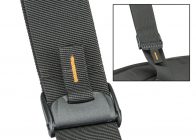 Manufacturer: 24/7
Manufacturer: 24/7
Collection: The Traffic Collection
Website: Click Here
Description: Bandolier-Style Camera Case Designed for Busy Areas
Purchase/Rent: Purchase
Pricing: $99.99
Video: Click Here
Purchase: Click Here
Expected Release: Available Now
Review Issue: #124 (06/16)
Reviewed By: Jeremy T. Hanke
Final Score: 9.0 (out of 10)
 When Adorama first began selling goods related to photography, it was strictly as a reseller of other companies’ products, much in the same way that Netflix began strictly as a redistributor of other people’s content. However, times change; Netflix now has an entire library of critically acclaimed self-created content, and Adorama carries products from nearly as many specialty companies it either owns or exclusively distributes for as it does other brands.
When Adorama first began selling goods related to photography, it was strictly as a reseller of other companies’ products, much in the same way that Netflix began strictly as a redistributor of other people’s content. However, times change; Netflix now has an entire library of critically acclaimed self-created content, and Adorama carries products from nearly as many specialty companies it either owns or exclusively distributes for as it does other brands.
Among the newest brands Adorama exclusively distributes is 24/7, a company which specializes in rugged bags for the hurried documentarian/filmmaker/photographer. With their debut release, the Traffic Collection, 24/7 has laser focused on the rigors of the creative who has to move through chaotic city streets on foot, bike, cab, or train, as well as for those trapped on cramped flights across the country.
Fortuitously, when I received the Sling—their largest DSLR bag—this spring, it was right before I made my way across the country from Lexington, KY to Yakima, WA for a two week shoot for a documentary on martial arts that explored Shudokan Karate and its most senior living master, Hanshi Morris Mack.
To put it through its paces, I would need to be able to keep my t3i with two lenses, two extra batteries, my charger, a hard SD card case, a battery backup, my iphone charging equipment, my h4n audio recorder, my desktop monopod, and my lens cleaners safely with me at all times, and still have room for my sunglasses and, due to my light sensitivity, my migraine medication. (And because of an overbooking forcing me to check my carry on with my laptop AFTER I removed its battery, The Sling would also have to make room for my bulky laptop battery for one flight.)
So how well did work? Read on to find out!
Ease of Use
Unlike a lot of bags with readjustable dividers, the Sling was actually quite easy to get set up the way I wanted it and I was surprised at how much I could fit into the bag, while still staying precisely at the size that the airlines define as a “personal item” (5-1/8″ wide x 17-3/4” high x 12-1/4” long). While there is always a bit of finagling with things to get things to fit the way you like, I found it quite intuitive to set up. (And yes, I was able to move things around to fit in my laptop battery in on that overbooked flight I mentioned.)
While it was easy to adjust the shoulder strap with a clever lock/release system into a comfortable bandolier position, the system includes an adjustable cross-strap for increased stability. Unfortunately, this was not very easy to use and had to be undone each time you wanted to switch the carrying location (unless you wanted to wriggle in and out of it). Eventually, I just ended up using it in the Bandolier position, leaving the cross strap dangling (as there’s no place to actually tuck/hide/detach the strap when it’s not in actual use).
To correct this for a future version, I’d love them to include a Quick release Harness System with Tuck Pockets. Ideally, this would be some sort of carabineer-style quick harness system that could tighten and loosen easily and that would allow you to go from just the bandolier strap to one or two stabilizing straps. The tuck pockets would let you hide the extra straps away when not in use (so they’re not dangling behind you, waiting to get caught in an elevator door or grabbed by someone’s curious child).
Depth of Options
Besides the adjustable dividers I already mentioned and some nice pen and media pockets sewn into the top of the bag, there are a surprising number of options included with this bag that I thought were very cool. I’ll mention the elements that I found the most helpful.
Back or Belly-Protective Carrying
When walking through the airports and cities on my journey, keeping the bag across my back was the most comfortable, but, when seated or when on the hunt for things to actually shoot, transitioning it to the frontal (belly-protective) position was definitely the safest and most comfortable. (While it does feel a bit awkwardly like a “pregnancy belly” prosthetic in this position, it serves its purpose and didn’t grow overly ungainly.)
Dual Access Entry
I kept my camera (with attached lens), an extra lens, and batteries in the lower area which normally would be accessed across your body (when you were carrying it in front), while I kept my H4N recorder, desktop monopod, cleaners, sunglasses, and meds in the top area, which both zips shut and/or straps down for extra security. (You can also unzip the divider between the areas, so there’s one large, undivided bag, if you need to.)
Side Access Sheathe
There’s a rear panel designed to store tablets or ipads with easy side access when you’ve got it across your stomach. While the 12” sheathe isn’t quite big enough for most laptops, it was surprisingly useful even without any electronics going there. I found that it was a great place to stash plane tickets and even had enough room for one of the thinner novels I was reading, so you could definitely put your camera manual there, if you prefer a hard copy.
Reflective Panels
Designed to keep you from getting hit by cars, the reflective panels on the bottom and sides of the Sling reflect traffic lights so that night drivers see you and can avoid hitting you.
Padded Accessory Bag
Although this is clearly designed to go into the bag for folks who weren’t carrying as many things in the main bag as I was, this accessory bag is really well padded and can be used as a small case on its own—or it can be used to add extra padding for especially fragile items with in the case. (It’s not waterproof, but it does have dual handles to hold onto, if you use it outside the bag.)
Water-Resistant Material (with Rain Sheathe)
The water resistance of this bag is very helpful, as I discovered when I took my gear to Forks, WA (the rainiest town in the USA, according to the US Census, which is why Stephanie Meyer chose it for the setting of her fictional Twilight books). Ironically, I didn’t discover the actual rain sheathe until after I arrived back home, due to its clever hidden pocket in the base of the bag.
Despite all the great options, there was one option that didn’t work well at all: the SD Card Holder. It was designed to hold an extra SD card for your camera, but isn’t actually affixed with anything more permanent than a tension clip system to the side flap pocket it’s stuck in. As such, every time I opened the side flap, the SD Card holder would go flying. (I ended up taking the card holder out of the bag before I had even arrived in Washington due to its lack of functionality. Probably will add some Velcro to it and replace it in the future.)
Despite all the great options the Sling has, there are a few options I’d love to see in the future:
SD Card Wallet
Rather than just affixing the single SD Card holder with Velcro, I’d love to see a soft, dual sided 8-10 count SD card wallet that Velcros securely into the attachment pocket.
Shotgun Sheath
It would be wonderful for DSLR filmmakers to have a padded tube—designed to keep a shotgun mic securely in place—that could extend the entire length of the bag. (Alternatively, they could include a padded waterproof tube with Velcro attachments that could stick to special Velcro patches on the side of the bag.)
Side Straps for a Small/Mini Tripod
Having a set of side straps to hook a small tripod to would have been unbelievably helpful in my trip, since you’re just not going to fit any but the micro-pods inside a case like this. (Obviously, some airlines may protest that you’re over your personal item size limit if you have a tripod strapped to it, but most will let you have a pass if the offending object could be held in your hands when you board the plane. For most other commuter situations, of course, this wouldn’t be an issue.)
Performance
The actual performance of a bag like this is measured in two different ways:
- How effective is it at protecting your equipment?
- How efficient/painless is it to use the product itself?
To answer this first question, the proof is in whether my equipment was safe and secure throughout the entire trip, after being jostled through airports, passed around karate dojos, and manhandled through zen gardens.
I’m pleased to say that it was indeed safe and secure. (And, even after all the stress the bag was put under during this trip, it came out, essentially, looking none the worse for wear.)
Now, as to how efficient and painless the product itself was to use, aside from the issue with the support strap which we mentioned earlier, the product efficient in most situations and there was virtually no back or shoulder strain from its use.
The only area that needs to be improved for a future model, in my opinion, is to give the bag a Non-Skid Base so that it doesn’t fall over or slide down when you’re on linoleum or other smooth flooring and need to lean the bag against a wall. (The only time I risked having some of my gear damaged in this testing was when I was on a hardwood floor and I’d leaned the Sling against a wall with the top pouch open. It slid down, dumping out my H4n and a number of other needed pieces of gear on to the hardwood. Fortunately, the H4n was still in its protective case and the other pieces were undamaged, but it’s an improvement which would not only help with safety, but also with make the gear easier to use.)
Value
While $100 isn’t super cheap for a camera case, the overall well designed layout of it, the high quality of the construction, how much you can actually store in it, and how safe it kept my gear throughout its intended use makes me conclude that this is a very good value for your money.
Final Comments
The Sling by 24/7 makes taking your camera and accessories along with you shockingly easy and convenient. And most importantly, it consistently kept them safe and secure, no matter what back alleys, airports, or—in the case of Forks—vampires we faced in the process.
|
Breakdown
|
|
|
Ease of Use
|
8.5 |
|
Depth of Options
|
9.5 |
|
Performance
|
9.0 |
|
Value vs. Cost
|
9.0 |
|
Overall Score |
9.0 |







